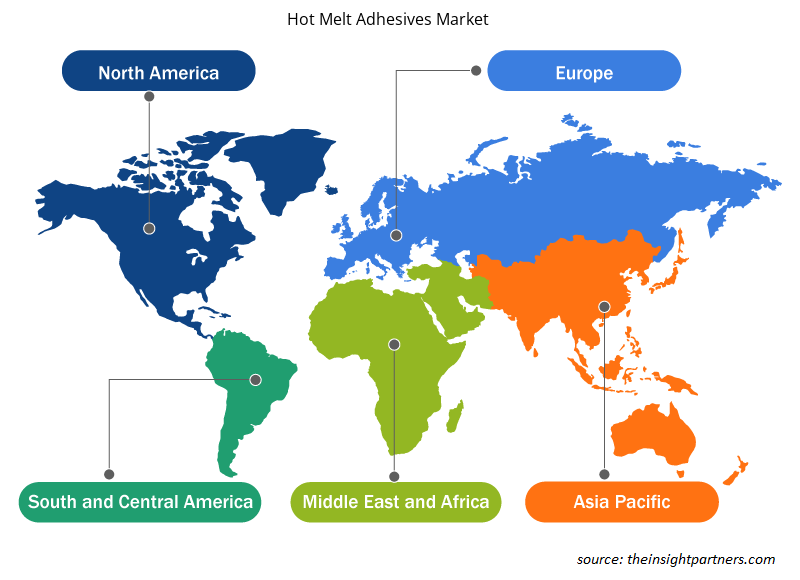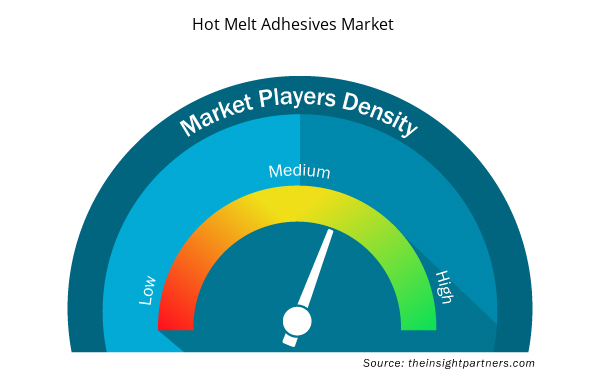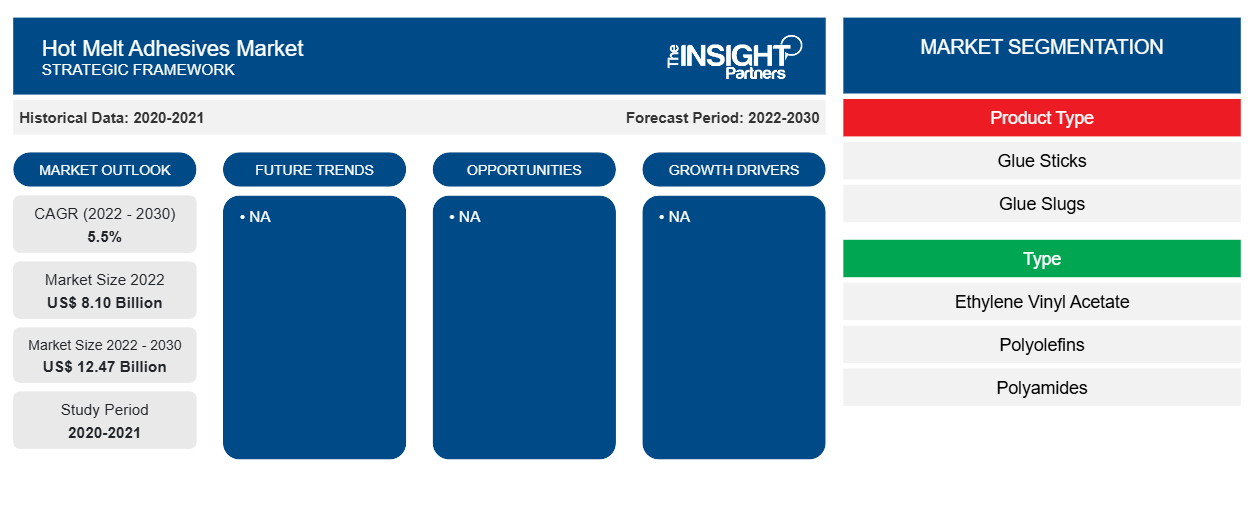Der Markt für Schmelzklebstoffe soll von 8,10 Milliarden US-Dollar im Jahr 2022 auf 12,47 Milliarden US-Dollar im Jahr 2030 wachsen; von 2022 bis 2030 wird eine durchschnittliche jährliche Wachstumsrate (CAGR) von 5,5 % erwartet. Die steigende Nachfrage aus der Verpackungsindustrie dürfte ein wichtiger Trend auf dem Markt für Schmelzklebstoffe bleiben.
Marktanalyse für Schmelzklebstoffe
Automobilhersteller verlangen innovative, hochwertige Materialien zur Herstellung von Automobilkomponenten. Schmelzklebstoffe gelten als eines der am besten geeigneten Materialien für leichte Automobilteile. Kohlenstofffaserverstärkte Verbundwerkstoffe werden als wichtige Materialien verwendet, um die Karosserie und andere Teile in Automobilen zu ersetzen. In der Automobilindustrie hat die Verwendung von Schmelzklebstoffen Bremsen, Lenkung, Haltbarkeit und Kraftstoffeffizienz verbessert, was zu Energieeinsparungen und einer Verringerung der Kohlendioxidemissionen führt. Führende Automobilhersteller verwenden Schmelzklebstoffe zur Herstellung von Komponenten. Beispielsweise besteht der Airbus A350 zu 52 % aus schmelzklebstoffverstärktem Kunststoff (CFK) und der BMW i3 hat größtenteils ein CFK-Chassis. Schmelzklebstoffe werden auch in hochwertigen Fahrradrahmen, Tennisschlägern und Surfbrettern verwendet. Da Schmelzklebstoffe einen hohen Modul und eine hohe spezifische Festigkeit, Dauerfestigkeit, Steifigkeit und Druckfestigkeit sowie einen niedrigeren Wärmeausdehnungskoeffizienten, Korrosionsbeständigkeit und andere vorteilhafte Eigenschaften bieten, werden sie in der Automobilindustrie und anderen industriellen Anwendungen häufig eingesetzt.
Marktübersicht für Schmelzklebstoffe
Schmelzklebstoffe oder Heißkleber sind Formulierungen aus thermoplastischen Klebstoffen. Heißklebestifte sind in verschiedenen Durchmessern und Ausführungen erhältlich. Die Stifte werden in die Heißklebepistole eingesetzt und auf die gewünschte Temperatur erhitzt, bis der Klebestift zu schmelzen beginnt. Der Klebstoff wird durch die erhitzte Düse auf die Anwendungsoberfläche gedrückt, wenn der Benutzer die Pistole mit dem mechanischen Auslöser durchdrückt. Einige Schmelzklebstoffe sind mit einer längeren offenen Zeit konzipiert, sodass sie zum Verkleben auf größere Flächen gesprüht werden können.
Passen Sie diesen Bericht Ihren Anforderungen an
Sie erhalten kostenlos individuelle Anpassungen an jedem Bericht, einschließlich Teilen dieses Berichts oder einer Analyse auf Länderebene, eines Excel-Datenpakets sowie tolle Angebote und Rabatte für Start-ups und Universitäten.
- Holen Sie sich die wichtigsten Markttrends aus diesem Bericht.Dieses KOSTENLOSE Beispiel umfasst eine Datenanalyse von Markttrends bis hin zu Schätzungen und Prognosen.
Treiber und Chancen auf dem Markt für Schmelzklebstoffe
Steigende Akzeptanz im Windenergiesektor fördert Wachstum auf dem Markt für Schmelzklebstoffe
Die wachsende Nachfrage nach erneuerbaren Ressourcen hat zu einem sprunghaften Anstieg der Installation und Nachfrage nach Windparks geführt. Große Landstriche und Küstengebiete werden für den Betrieb von Windturbinen genutzt. Die Hersteller von Windturbinen sind bestrebt, effizientere und längere Rotorblätter herzustellen. Moderne Verbundwerkstoffe wie Schmelzklebstoffe spielen eine immer größere Rolle bei der Konstruktion von Windturbinen, insbesondere der Rotorblätter. Die auf dem Markt tätigen Unternehmen haben festgestellt, dass mehr Energie erzeugt werden kann, je länger die Rotorblätter einer Turbine sind. Schmelzklebstoffe spielen in der Windenergiebranche eine sehr wichtige Rolle. Große Rotorblätter werden normalerweise nach Steifigkeit und Durchbiegung konstruiert, anstatt die Materialstärke zu berücksichtigen. Die hohe Steifigkeit von Schmelzklebstoffen verringert die Durchbiegung der Rotorblätter und ermöglicht so einen größeren Turmdurchmesser bei einem bestimmten Abstand zwischen Rotorblättern. Schmelzklebstoffe werden dem Holmgurt hinzugefügt, der das Rückgrat des Rotorblatts bildet.
Zunehmender Einsatz von Schmelzklebstoffen in der Sportartikelindustrie
Die hohe Festigkeit, Elastizität und Leichtigkeit von Schmelzklebstoffen haben zu einer steigenden Nachfrage in der Sportartikelindustrie geführt. Sportartikel wie Golfschläger, Schläger, Skier, Snowboards, Hockeyschläger, Angelruten, Schläger und Fahrräder werden unter Verwendung von Schmelzklebstoffen hergestellt. Schmelzklebstoffe bieten Designflexibilität bei der Entwicklung hochspezifischer Anwendungen. Die genaue Form der Ausrüstung, die für ihre Leistung entscheidend ist, lässt sich mit Schmelzklebstoffen leicht erreichen. Schmelzklebstoffe tragen zur Leistungssteigerung von Radfahrern und Golfern bei. Die spezifischste Verwendung von Schmelzklebstoffen in Sportgeräten findet sich bei Tennisschlägern. Spieler können mit dem leichteren Schläger schnellere Bälle schlagen und den Ball mit einer größeren Schlägerfläche besser kontrollieren. Diese Faktoren treiben die Nachfrage nach Schmelzklebstoffen in verschiedenen Sportgeräten an. Die steigende Nachfrage nach Sportgeräten auf Basis von Schmelzklebstoffen bietet wichtige und neue Marktteilnehmer mit lukrativen Marktchancen.racquets, skis, snowboards, hockey sticks, fishing rods, bats, and bicycles are manufactured using hot melt adhesives. Hot melt adhesives provide design flexibility when designing highly specific applications. The precise shape of equipment, which is critical to its performance, is easily achieved with the use of hot melt adhesive materials. Hot melt adhesives help enhance the performance of bikers and golfers. The most specific use of hot melt adhesives in sporting equipment is seen in the tennis racket. Players can hit faster balls with the lighter racket and control the ball better with a larger area of the racket. These factors are driving the demand for hot melt adhesives in various sporting equipment. The increasing demand for hot melt adhesive-based sporting equipment provides a lucrative market opportunity for key and new market players.
Segmentierungsanalyse des Marktberichts für Schmelzklebstoffe
Wichtige Segmente, die zur Ableitung der Marktanalyse für Schmelzklebstoffe beigetragen haben , sind Produkttyp, Typ und Anwendung.
- Basierend auf dem Produkttyp ist der Markt für Schmelzklebstoffe in Klebestifte, Klebeblöcke und andere unterteilt. Das Segment Klebestifte hatte im Jahr 2022 den größten Marktanteil.
- Nach Typ wird der Markt für Schmelzklebstoffe in Ethylenvinylacetat, Polyolefine, Polyamide, Polyurethane, Styrolblockcopolymere und andere unterteilt. Das Segment Ethylenvinylacetat hatte im Jahr 2022 den größten Marktanteil.
- Nach Anwendung ist der Markt in Verpackung, Bau, Automobil, Möbel, Schuhe, Elektronik und andere unterteilt. Das Verpackungssegment hatte im Jahr 2022 den größten Marktanteil.
Marktanteilsanalyse für Schmelzklebstoffe nach geografischer Lage
Der geografische Umfang des Marktberichts für Schmelzklebstoffe ist hauptsächlich in fünf Regionen unterteilt: Nordamerika, Asien-Pazifik, Europa, Naher Osten und Afrika sowie Süd- und Mittelamerika.
Der asiatisch-pazifische Raum dominiert den Markt. Die Schwellenländer erleben einen Aufschwung der Industrialisierung, vor allem in den Bereichen Fertigung, Automobil, Verpackung und Bauwesen, was den wichtigsten Marktteilnehmern auf dem Markt für Schmelzklebstoffe weitere reichliche Chancen bietet. Länder wie Australien, Japan, Indien, China, Südkorea, Singapur, Taiwan und Indonesien verfügen über große Fertigungsindustrien in verschiedenen Sektoren, darunter Chemie, Textilien, Zellstoff und Papier sowie Elektronik. Die Fertigungssektoren in diesen Ländern haben im Laufe der Jahre einen enormen Wandel erlebt. Der Fertigungssektor im asiatisch-pazifischen Raum setzt in hohem Maße auf Innovationsbeschleuniger, die fortschrittliche Technologien und Prozesse umfassen. In den letzten Jahrzehnten sind die Ausgaben der Fertigungsunternehmen in der Region erheblich gestiegen und es wird erwartet, dass sie auch in Zukunft mit der höchsten geschätzten Wachstumsrate wachsen werden.
Regionale Einblicke in den Markt für Schmelzklebstoffe
Die regionalen Trends und Faktoren, die den Markt für Schmelzklebstoffe während des Prognosezeitraums beeinflussen, wurden von den Analysten von Insight Partners ausführlich erläutert. In diesem Abschnitt werden auch die Marktsegmente und die Geografie für Schmelzklebstoffe in Nordamerika, Europa, im asiatisch-pazifischen Raum, im Nahen Osten und Afrika sowie in Süd- und Mittelamerika erörtert.

- Erhalten Sie regionale Daten zum Markt für Schmelzklebstoffe
Umfang des Marktberichts über Schmelzklebstoffe
| Berichtsattribut | Details |
|---|---|
| Marktgröße im Jahr 2022 | 8,10 Milliarden US-Dollar |
| Marktgröße bis 2030 | 12,47 Milliarden US-Dollar |
| Globale CAGR (2022 - 2030) | 5,5 % |
| Historische Daten | 2020-2021 |
| Prognosezeitraum | 2022–2030 |
| Abgedeckte Segmente | Nach Produkttyp
|
| Abgedeckte Regionen und Länder | Nordamerika
|
| Marktführer und wichtige Unternehmensprofile |
|
Marktteilnehmerdichte für Schmelzklebstoffe: Auswirkungen auf die Geschäftsdynamik verstehen
Der Markt für Schmelzklebstoffe wächst rasant, angetrieben durch die steigende Nachfrage der Endverbraucher aufgrund von Faktoren wie sich entwickelnden Verbraucherpräferenzen, technologischen Fortschritten und einem größeren Bewusstsein für die Vorteile des Produkts. Mit steigender Nachfrage erweitern Unternehmen ihr Angebot, entwickeln Innovationen, um die Bedürfnisse der Verbraucher zu erfüllen, und nutzen neue Trends, was das Marktwachstum weiter ankurbelt.
Die Marktteilnehmerdichte bezieht sich auf die Verteilung der Firmen oder Unternehmen, die in einem bestimmten Markt oder einer bestimmten Branche tätig sind. Sie gibt an, wie viele Wettbewerber (Marktteilnehmer) in einem bestimmten Marktraum im Verhältnis zu seiner Größe oder seinem gesamten Marktwert präsent sind.
Die wichtigsten auf dem Markt für Schmelzklebstoffe tätigen Unternehmen sind:
- HB Fuller Company
- Henkel AG & COMPANY, KGAA
- Arkema
- 3M
- Sika AG
Haftungsausschluss : Die oben aufgeführten Unternehmen sind nicht in einer bestimmten Reihenfolge aufgeführt.

- Überblick über die wichtigsten Akteure auf dem Markt für Schmelzklebstoffe
Nachrichten und aktuelle Entwicklungen zum Schmelzklebstoffmarkt
Der Markt für Schmelzklebstoffe wird durch die Erhebung qualitativer und quantitativer Daten nach Primär- und Sekundärforschung bewertet, die wichtige Unternehmensveröffentlichungen, Verbandsdaten und Datenbanken umfasst. Im Folgenden finden Sie eine Liste der Entwicklungen auf dem Markt:
- LINTEC gab bekannt, dass es einen permanenten Allzweck-Schmelzklebstoff entwickelt hat und diesen nun in einer neuen Etikettenserie namens HVT verwendet. Am 1. Februar wird das Unternehmen drei neue Produkte mit diesem neuen Klebstoff auf den Markt bringen: zwei synthetische papierbasierte und ein wasserfestes papierbasiertes Produkt für Nutztiere. Sie sollen für eine breite Palette von Anwendungen nützlich sein, darunter verschiedene Arten von Displayetiketten. (Quelle: LINTEC Corporation, Unternehmenswebsite, 2023)
Marktbericht zu Schmelzklebstoffen – Umfang und Ergebnisse
Der Bericht „Marktgröße und Prognose für Schmelzklebstoffe (2020–2030)“ bietet eine detaillierte Analyse des Marktes, die die folgenden Bereiche abdeckt:
- Marktgröße und Prognose auf globaler, regionaler und Länderebene für alle wichtigen Marktsegmente, die im Rahmen des Projekts abgedeckt sind
- Marktdynamik wie Treiber, Beschränkungen und wichtige Chancen
- Wichtige Zukunftstrends
- Detaillierte Porter's Five Forces und SWOT-Analyse
- Globale und regionale Marktanalyse mit wichtigen Markttrends, wichtigen Akteuren, Vorschriften und aktuellen Marktentwicklungen
- Branchenlandschaft und Wettbewerbsanalyse, einschließlich Marktkonzentration, Heatmap-Analyse, prominenten Akteuren und aktuellen Entwicklungen
- Detaillierte Firmenprofile
- Historische Analyse (2 Jahre), Basisjahr, Prognose (7 Jahre) mit CAGR
- PEST- und SWOT-Analyse
- Marktgröße Wert/Volumen – Global, Regional, Land
- Branche und Wettbewerbsumfeld
- Excel-Datensatz



Report Coverage
Revenue forecast, Company Analysis, Industry landscape, Growth factors, and Trends

Segment Covered
This text is related
to segments covered.

Regional Scope
North America, Europe, Asia Pacific, Middle East & Africa, South & Central America

Country Scope
This text is related
to country scope.
Trends and growth analysis reports related to Chemicals and Materials : READ MORE..
- H.B. Fuller Company
- Henkel AG & COMPANY, KGAA
- Arkema
- 3M
- Sika AG
- Jowat SE
- Hexcel Corporation
- The Dow Chemical Company
- Beardow Adams
- Gorilla Glue Company
The Insight Partners performs research in 4 major stages: Data Collection & Secondary Research, Primary Research, Data Analysis and Data Triangulation & Final Review.
- Data Collection and Secondary Research:
As a market research and consulting firm operating from a decade, we have published and advised several client across the globe. First step for any study will start with an assessment of currently available data and insights from existing reports. Further, historical and current market information is collected from Investor Presentations, Annual Reports, SEC Filings, etc., and other information related to company’s performance and market positioning are gathered from Paid Databases (Factiva, Hoovers, and Reuters) and various other publications available in public domain.
Several associations trade associates, technical forums, institutes, societies and organization are accessed to gain technical as well as market related insights through their publications such as research papers, blogs and press releases related to the studies are referred to get cues about the market. Further, white papers, journals, magazines, and other news articles published in last 3 years are scrutinized and analyzed to understand the current market trends.
- Primary Research:
The primarily interview analysis comprise of data obtained from industry participants interview and answers to survey questions gathered by in-house primary team.
For primary research, interviews are conducted with industry experts/CEOs/Marketing Managers/VPs/Subject Matter Experts from both demand and supply side to get a 360-degree view of the market. The primary team conducts several interviews based on the complexity of the markets to understand the various market trends and dynamics which makes research more credible and precise.
A typical research interview fulfils the following functions:
- Provides first-hand information on the market size, market trends, growth trends, competitive landscape, and outlook
- Validates and strengthens in-house secondary research findings
- Develops the analysis team’s expertise and market understanding
Primary research involves email interactions and telephone interviews for each market, category, segment, and sub-segment across geographies. The participants who typically take part in such a process include, but are not limited to:
- Industry participants: VPs, business development managers, market intelligence managers and national sales managers
- Outside experts: Valuation experts, research analysts and key opinion leaders specializing in the electronics and semiconductor industry.
Below is the breakup of our primary respondents by company, designation, and region:

Once we receive the confirmation from primary research sources or primary respondents, we finalize the base year market estimation and forecast the data as per the macroeconomic and microeconomic factors assessed during data collection.
- Data Analysis:
Once data is validated through both secondary as well as primary respondents, we finalize the market estimations by hypothesis formulation and factor analysis at regional and country level.
- Macro-Economic Factor Analysis:
We analyse macroeconomic indicators such the gross domestic product (GDP), increase in the demand for goods and services across industries, technological advancement, regional economic growth, governmental policies, the influence of COVID-19, PEST analysis, and other aspects. This analysis aids in setting benchmarks for various nations/regions and approximating market splits. Additionally, the general trend of the aforementioned components aid in determining the market's development possibilities.
- Country Level Data:
Various factors that are especially aligned to the country are taken into account to determine the market size for a certain area and country, including the presence of vendors, such as headquarters and offices, the country's GDP, demand patterns, and industry growth. To comprehend the market dynamics for the nation, a number of growth variables, inhibitors, application areas, and current market trends are researched. The aforementioned elements aid in determining the country's overall market's growth potential.
- Company Profile:
The “Table of Contents” is formulated by listing and analyzing more than 25 - 30 companies operating in the market ecosystem across geographies. However, we profile only 10 companies as a standard practice in our syndicate reports. These 10 companies comprise leading, emerging, and regional players. Nonetheless, our analysis is not restricted to the 10 listed companies, we also analyze other companies present in the market to develop a holistic view and understand the prevailing trends. The “Company Profiles” section in the report covers key facts, business description, products & services, financial information, SWOT analysis, and key developments. The financial information presented is extracted from the annual reports and official documents of the publicly listed companies. Upon collecting the information for the sections of respective companies, we verify them via various primary sources and then compile the data in respective company profiles. The company level information helps us in deriving the base number as well as in forecasting the market size.
- Developing Base Number:
Aggregation of sales statistics (2020-2022) and macro-economic factor, and other secondary and primary research insights are utilized to arrive at base number and related market shares for 2022. The data gaps are identified in this step and relevant market data is analyzed, collected from paid primary interviews or databases. On finalizing the base year market size, forecasts are developed on the basis of macro-economic, industry and market growth factors and company level analysis.
- Data Triangulation and Final Review:
The market findings and base year market size calculations are validated from supply as well as demand side. Demand side validations are based on macro-economic factor analysis and benchmarks for respective regions and countries. In case of supply side validations, revenues of major companies are estimated (in case not available) based on industry benchmark, approximate number of employees, product portfolio, and primary interviews revenues are gathered. Further revenue from target product/service segment is assessed to avoid overshooting of market statistics. In case of heavy deviations between supply and demand side values, all thes steps are repeated to achieve synchronization.
We follow an iterative model, wherein we share our research findings with Subject Matter Experts (SME’s) and Key Opinion Leaders (KOLs) until consensus view of the market is not formulated – this model negates any drastic deviation in the opinions of experts. Only validated and universally acceptable research findings are quoted in our reports.
We have important check points that we use to validate our research findings – which we call – data triangulation, where we validate the information, we generate from secondary sources with primary interviews and then we re-validate with our internal data bases and Subject matter experts. This comprehensive model enables us to deliver high quality, reliable data in shortest possible time.


 Holen Sie sich ein kostenloses Muster für diesen Bericht
Holen Sie sich ein kostenloses Muster für diesen Bericht